Managing diabetes in cats is a critical aspect of ensuring their health and well-being.
If you’re caring for a diabetic cat, understanding how to determine the maximum insulin dose for your feline friend is essential for effective management.
Obtaining the right dosage can help regulate blood sugar levels and improve quality of life, but it requires careful monitoring and adjustment.
When it comes to insulin therapy, dosage can vary widely based on factors such as your cat’s weight and specific health needs.
Most veterinarians recommend starting with a low dose, gradually adjusting it based on your cat’s response and blood glucose readings.
Being vigilant about these adjustments is important to prevent complications, which can arise from both underdosing and overdosing.
If you’re navigating the complexities of feline diabetes, knowing how to calculate the appropriate insulin dose is just the beginning of your journey.
With the right approach and support, you can help your cat lead a happier, healthier life despite their condition.
Key Takeaways
- Determining insulin dosage is crucial for managing feline diabetes effectively.
- Regular monitoring of blood glucose levels helps tailor treatment.
- Understanding potential complications can aid in providing better care.
Understanding Feline Diabetes
Feline diabetes is a condition that affects your cat’s ability to regulate blood sugar.
This section will explore key aspects of diabetes in cats, including its types, signs that you might notice, ways to diagnose it, and factors that can contribute to the disease.
Types of Diabetes in Cats
Most commonly, cats experience diabetes mellitus, which has two main types.
- Type 1 Diabetes: This type is rare in cats and involves the complete lack of insulin production due to damaged pancreatic cells.
- Type 2 Diabetes: This is the more frequent type in feline patients. It occurs when your cat’s body becomes resistant to insulin, making it less effective in lowering blood sugar levels.
Cats diagnosed with type 2 diabetes often exhibit obesity, which is a significant risk factor.
Clinical Signs of Feline Diabetes
Recognizing the signs of diabetes is crucial for early detection and treatment.
Common symptoms include:
- Increased Thirst: You may notice your cat drinking much more water than usual.
- Increased Urination: This often goes hand in hand with increased thirst. You might find more urine in the litter box.
- Weight Loss: Despite having a good appetite, your cat may lose weight because their body isn’t using glucose properly.
Other signs can include lethargy, a dull coat, or even changes in behavior.
If you notice these symptoms, a veterinary visit is essential.
Diagnosing Diabetes in Cats
Diagnosing diabetes typically involves a combination of physical exams, history, and laboratory tests.
Your vet will likely:
- Perform a Physical Examination: Checking for signs like weight loss or dehydration.
- Blood Tests: Measuring blood glucose levels is a primary method for diagnosis.
- Urinalysis: Your vet may check for glucose in the urine, which indicates that blood sugar levels are too high.
These tests help determine if your cat has diabetes and the severity of the condition.
Early diagnosis can lead to better management and outcomes.
Risk Factors and Prevention
Certain risk factors can increase your cat’s chances of developing diabetes.
These include:
- Obesity: Being overweight is the most significant risk factor for diabetes in cats.
- Age: Older cats are more prone to diabetes.
- Inactivity: Cats that lead a sedentary lifestyle may be more susceptible.
To help prevent diabetes, ensure your cat maintains a healthy weight through proper diet and regular exercise.
Regular veterinary check-ups will also help catch any early signs of health issues.
Insulin Therapy for Cats
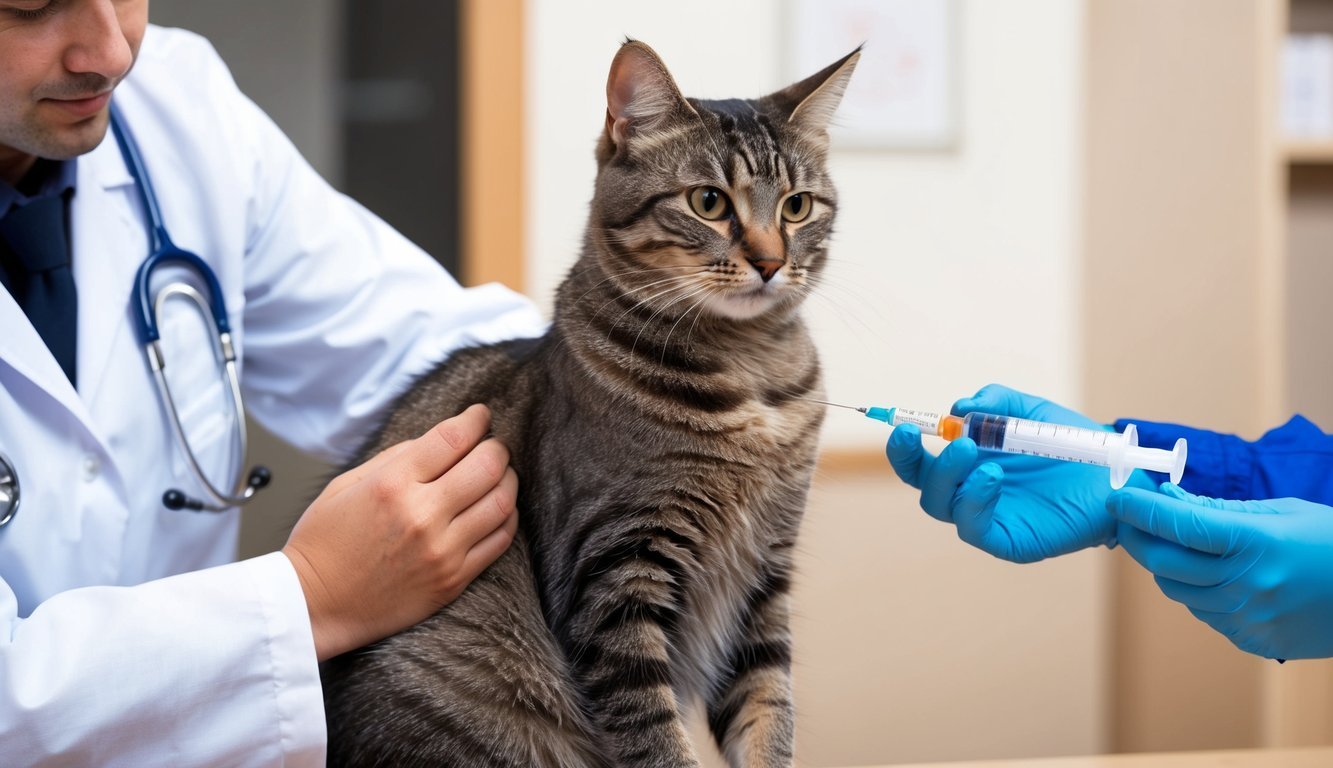
Managing diabetes in cats often involves insulin therapy, a critical aspect to ensure your cat’s health.
You’ll need to understand how insulin works, the types available, proper administration techniques, and how to monitor blood glucose effectively.
Introduction to Insulin Usage in Cats
Insulin is essential for diabetic cats as it helps regulate blood glucose levels.
Starting with a safe and effective dose is crucial.
For most cats, the initial dosing typically ranges from 0.25 to 2 units per injection, administered twice daily.
This encourages glucose metabolism, minimizing symptoms of diabetes.
Cats may respond differently to insulin.
Factors like weight and diet influence the dosage and frequency of administration.
Regular follow-ups with your veterinarian will help refine the dosage based on your cat’s response and blood glucose readings.
Different Types of Insulin
There are various types of insulin used in feline diabetes management.
The two most common types include:
-
Glargine (Lantus): Known for its long-acting effects, glargine provides a steady release of insulin, helping to keep blood glucose levels stable.
-
Protamine Zinc Insulin (PZI): This intermediate-acting insulin is another popular choice. It has a longer duration effect, making it suitable for many cats.
A third option, Vetsulin, is FDA-approved and designed specifically for dogs and cats.
Its intermediate duration allows for effective blood glucose control.
Choosing the right insulin type can make a significant difference in management strategies, so discuss options with your vet.
Insulin Injection Techniques
Proper insulin injection techniques are vital for ensuring your cat receives the necessary dosage.
Follow these steps for effective administration:
- Preparation: Gather your supplies, including a syringe or insulin pen, and ensure your cat is comfortable.
- Choose the Site: The preferred injection sites are your cat’s scruff or side, where there is loose skin. Rotate injection sites to prevent irritation.
- Injecting: Pinch the skin and insert the needle quickly at a 45-degree angle. Inject the insulin slowly and smoothly.
After administration, observe for any adverse reactions.
Ensure that your cat is calm and relaxed during the process.
Consistency in the injection schedule is key for effective management.
Monitoring Blood Glucose Levels
Monitoring your cat’s blood glucose is crucial for effective diabetes management.
Here are several methods:
-
Home Glucose Monitoring: Utilize a glucometer to check your cat’s blood sugar at home. This allows for immediate adjustments in insulin dosing.
-
Blood Glucose Curves: Conduct a blood glucose curve periodically. This entails measuring blood glucose levels at intervals throughout the day to assess how well the insulin is working.
-
Fructosamine Testing: A fructosamine test provides an average of glucose levels over the previous few weeks, offering insight into long-term control.
Consider continuous blood glucose monitoring systems if your cat requires intensive management.
Regular monitoring will help you and your vet make informed decisions, ensuring the best care for your feline companion.
Calculating the Insulin Dose
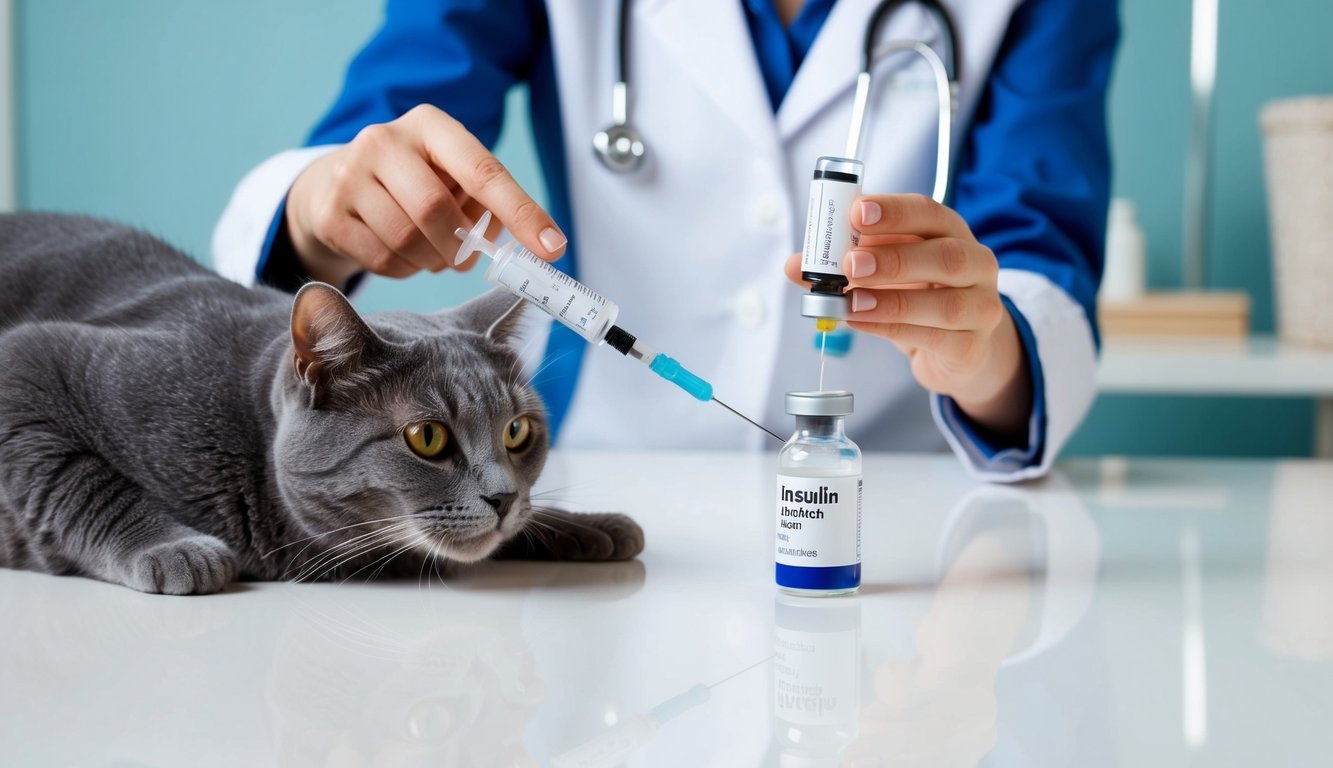
Determining the correct insulin dosage for your cat with diabetes is critical for effective management.
The process involves starting with an initial dose and making adjustments based on your cat’s response and ideal body weight.
Starting Doses and Adjustments
When you begin insulin therapy, the initial recommended dose typically falls between 1-2 units twice daily for most cats.
This initial dose can vary based on insulin type and your cat’s unique needs.
For larger cats, the starting dose should not exceed 2 units per injection.
You may see your veterinarian suggest doses around 0.5 U/kg, with a general range of 0.2–0.8 U/kg.
Monitoring your cat’s blood glucose levels will help you and your vet determine whether adjustments are necessary.
The Insulin Dosing Process
The dosing process begins with careful assessment.
Your veterinarian will consider factors like your cat’s weight, overall health, and any symptoms of diabetes.
After the initial dose is set, closely monitoring glucose levels—ideally every 1-2 weeks—enables you to track how well the insulin works.
If your cat shows signs of hypoglycemia, or if glucose levels remain high, adjustments can be made promptly.
Use a glucose meter to regularly check levels.
This information helps you identify patterns and make adjustments as needed.
Insulin Dose Titration
Titration is the method through which you refine and adjust your cat’s insulin dosage for optimal glycaemic control.
Based on monitoring results, you might need to increase or decrease the dose.
Start with small adjustments, typically 0.5 U.
If your cat experiences weight loss or continued high glucose readings, it may indicate the need for a dose increase.
Conversely, if your cat shows hypo signs, lowering the dose is crucial.
Keeping a log of your cat’s weight, insulin doses, and glucose readings will aid in this process.
Remember, every cat is unique, so customizing the insulin dose is essential for effective diabetes management.
Potential Complications
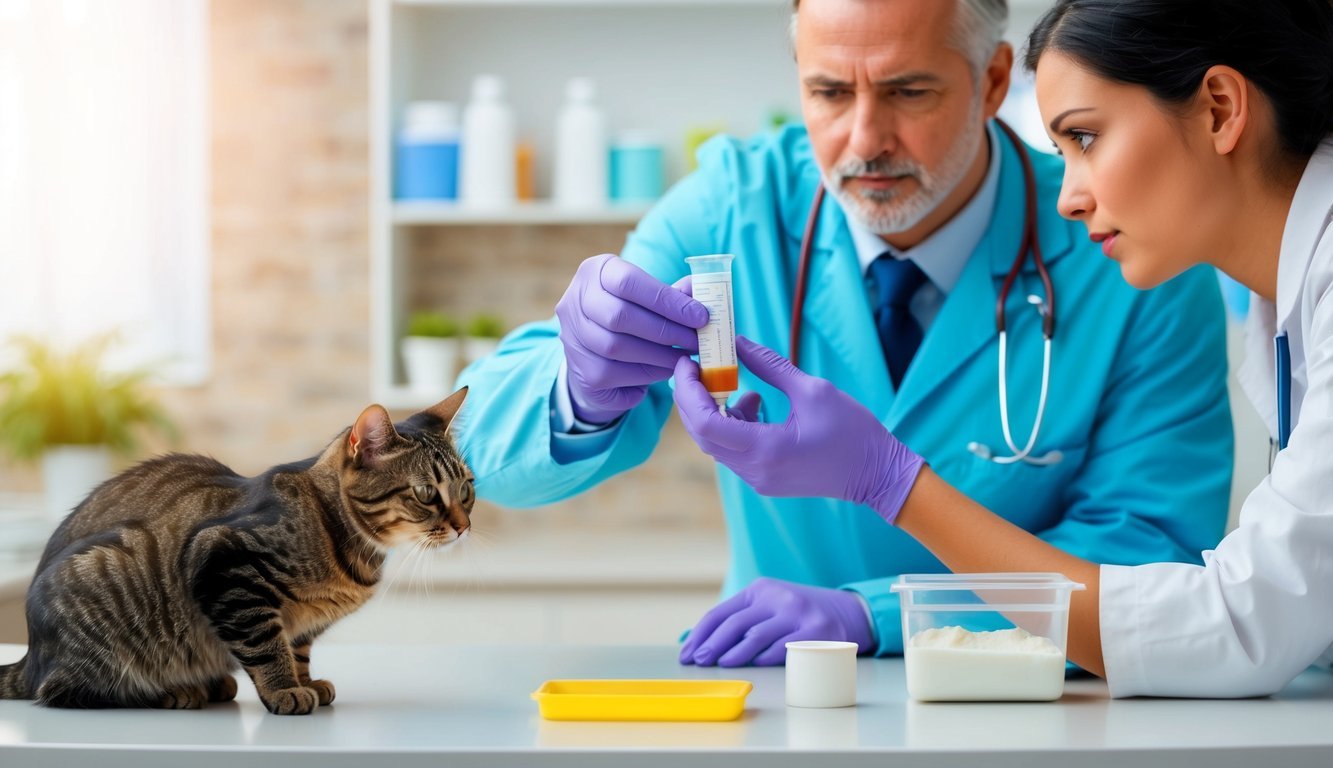
Managing insulin doses in cats is crucial to avoid serious health risks.
It’s important to understand potential complications that can arise from either too little or too much insulin.
Hypoglycemia and Hyperglycemia
Hypoglycemia occurs when your cat’s blood sugar drops too low, often due to excessive insulin administration.
Symptoms may include shaking, lethargy, and even seizures.
If you notice these signs, it’s vital to offer a quick source of sugar, like corn syrup, to raise their blood sugar levels.
On the other hand, hyperglycemia means your cat’s blood sugar levels are too high.
This can happen if the insulin dose is insufficient.
Signs include increased thirst and urination, known as glycosuria, where glucose spills into the urine.
Regular monitoring of your cat’s blood sugar can help manage these fluctuations.
Diabetic Ketoacidosis
Diabetic ketoacidosis (DKA) is a severe condition that may occur in poorly managed diabetic cats.
It happens when there isn’t enough insulin for glucose utilization, leading the body to break down fat for energy.
This process results in the buildup of ketones, which can cause serious health issues.
Symptoms of DKA include excessive drinking, vomiting, and a distinct fruity odor on the breath.
Rapid veterinary intervention is essential as this condition can be life-threatening.
Regular check-ups are recommended to catch any early signs of trouble.
Peripheral Neuropathy
Peripheral neuropathy is a complication associated with long-standing diabetes.
It occurs due to prolonged high blood sugar levels damaging the nerves.
In cats, this can lead to symptoms like a noticeable weakness in the hind limbs or difficulty walking.
Knowing your cat’s insulin levels and adjusting the dosage properly can help minimize the risk of neuropathy.
Monitoring for changes in mobility is important, as early intervention can prevent further nerve damage.
Insulin Overdose
An insulin overdose is another critical concern.
When the insulin dose exceeds the cat’s needs, it can lead to severe hypoglycemia.
If you suspect your cat has received too much insulin, act quickly by checking their blood sugar and offering sugar to counteract the drop.
Signs of an overdose might include excessive drooling, confusion, or unusual behavior.
Regular consultations with your veterinarian can help fine-tune insulin doses to prevent such an incident.
Keep a close eye on your cat’s reaction during adjustments.
Managing Feline Diabetes
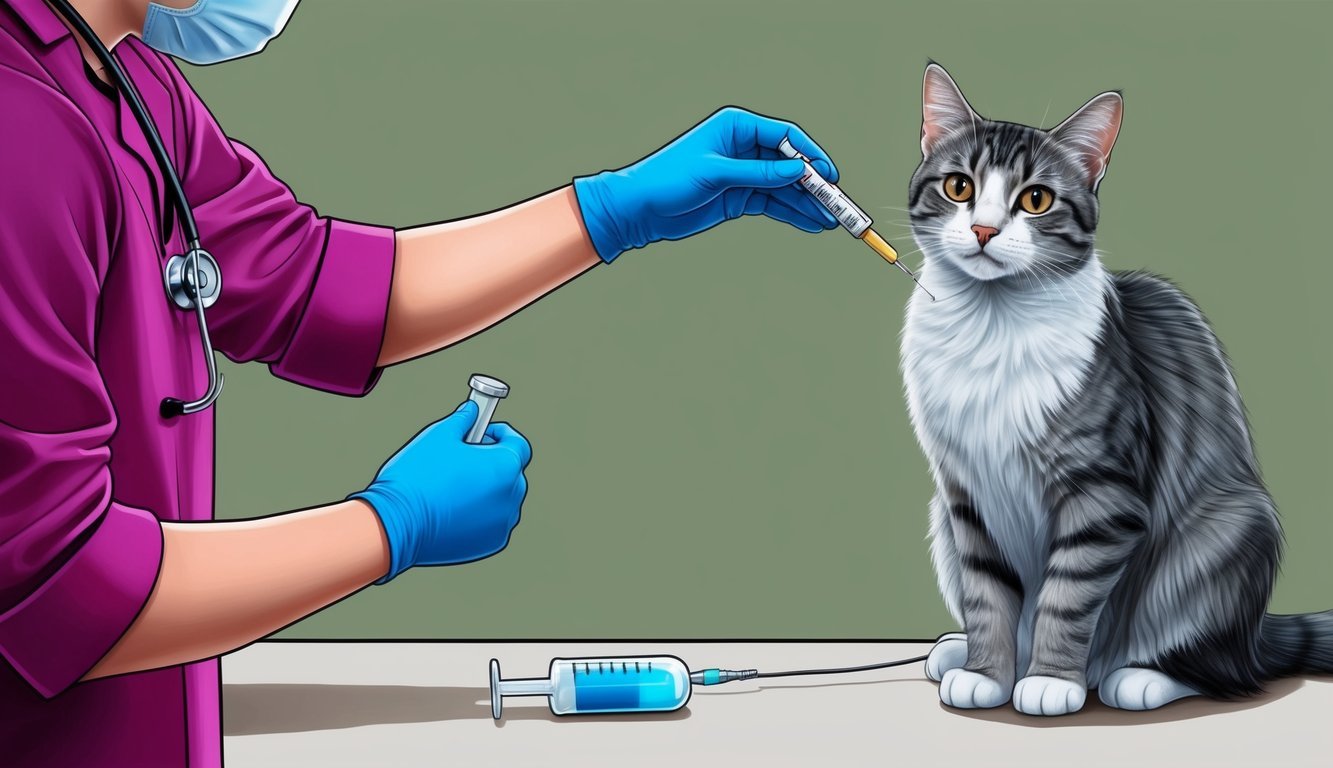
Managing feline diabetes is crucial for your cat’s health and wellbeing.
Several factors come into play, including diet, physical activity, and the potential for diabetic remission.
Focusing on these areas can help maintain glycemic control and improve your cat’s quality of life.
Diet and Nutrition
Diet plays a fundamental role in managing diabetes in cats.
A low-carbohydrate diet is often recommended, as it can help stabilize blood sugar levels.
Look for high-quality protein sources and avoid fillers like corn or wheat.
Consider using wet food over dry, as it typically has fewer carbohydrates and more moisture, promoting hydration.
You might also want to consult with a veterinarian for specific dietary recommendations tailored to your cat’s needs.
Monitor portion sizes closely to avoid obesity, which can complicate diabetes management.
Feeding your cat smaller, more frequent meals can also help maintain stable blood sugar levels throughout the day.
Physical Activity and Weight Management
Encouraging regular physical activity is essential for managing your cat’s diabetes.
Interactive play sessions can help reduce weight and promote better glucose metabolism.
Activities such as feather wands, laser pointers, or even simple chasing games can keep your cat engaged and active.
Keeping your cat at a healthy weight is vital.
Obesity increases the risk of insulin resistance, making diabetes harder to manage.
Regularly monitor your cat’s weight and adjust their diet or activity level as needed.
Consult with your veterinarian for tailored exercise recommendations.
They can also suggest weight-loss programs that incorporate both dietary adjustments and increased physical activity.
Achieving Diabetic Remission
Diabetic remission is a goal that many cat owners hope to achieve.
This occurs when a diabetic cat no longer requires insulin treatment or achieves stable blood sugar levels through diet alone.
Certain factors can contribute to remission, including weight loss and a strict low-carbohydrate diet.
Dietary therapy is crucial, as it helps stabilize glucose levels and promotes better overall metabolic health.
Be vigilant about monitoring your cat’s glucose levels closely during this process.
Regular vet check-ups are also essential to assess your cat’s progress and make necessary adjustments.
With dedication and the right approach, you can improve your cat’s chances of achieving remission which significantly enhances their quality of life.
Advanced Treatment Options
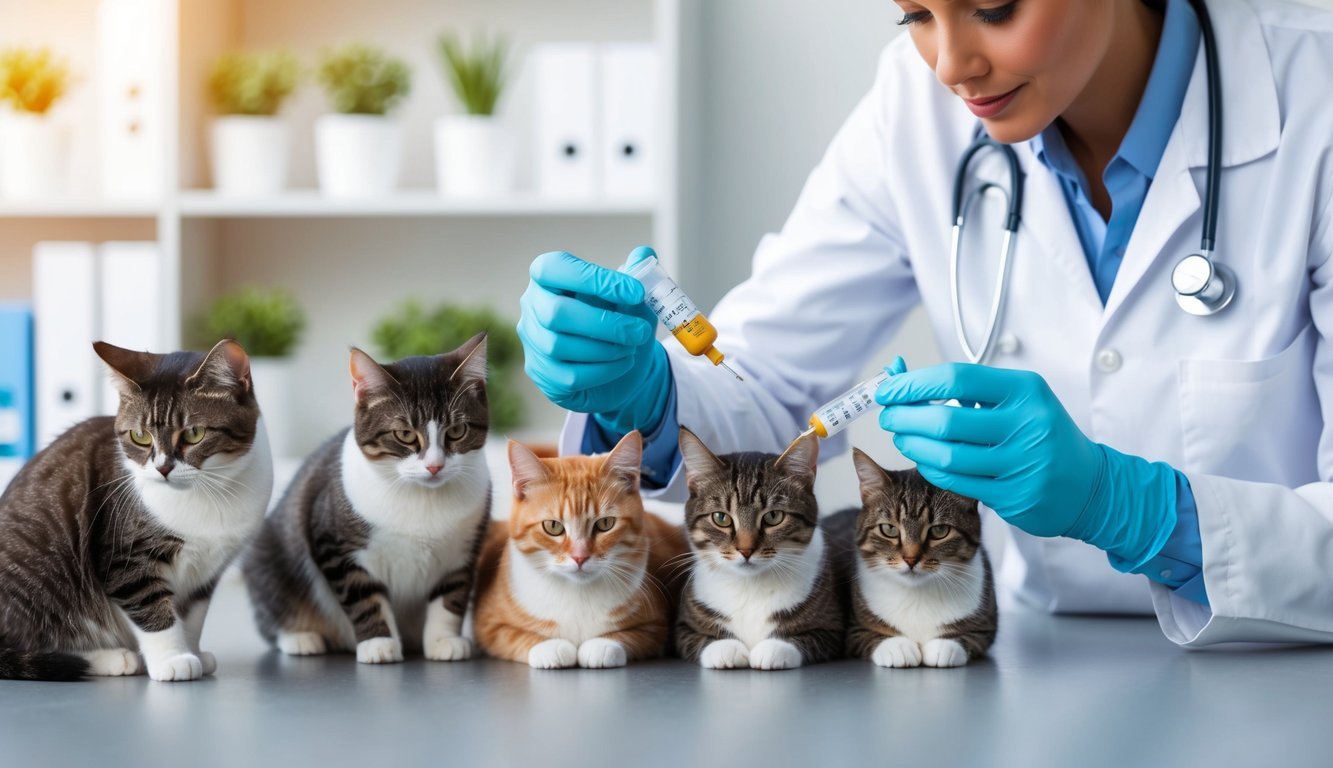
Managing diabetes in cats may go beyond traditional insulin shots.
There are several advanced treatment options available that can help you maintain your cat’s health and monitor glucose levels more effectively.
Continuous Glucose Monitoring Systems
Continuous Glucose Monitoring (CGM) systems offer real-time feedback on your cat’s blood glucose levels.
These devices use sensors placed under the skin to track glucose fluctuations throughout the day.
By providing constant data, you can quickly identify trends or sudden changes.
This helps in adjusting insulin dosages more accurately.
CGM systems can reduce the number of blood draws you need to perform at home, making monitoring less invasive.
Some popular CGM systems are compatible with mobile devices for easy access to data.
If you’re considering this option, consult your veterinarian to ensure the device fits your cat’s needs.
Innovative Insulin Products
Recent advancements in insulin formulations have introduced new options beyond standard treatments.
Products like glucagon-like peptide-1 (GLP-1) agonists and long-acting insulin can provide better glycemic control.
Additionally, the VetPen, a pen injector designed specifically for pets, offers an easier way to administer insulin.
This system can increase accuracy and reduce the likelihood of injection-related complications.
Make sure to discuss these innovative products with your veterinarian to determine the best fit for your cat’s specific condition and lifestyle.
Clinical Trials and Research
Ongoing clinical trials are exploring new avenues for diabetes management in cats.
This includes studies on novel insulin types and alternative treatment methods such as oral medications.
For example, some trials involve examining the efficacy of drugs like Bexacat and Senvelgo as alternatives to traditional insulin therapy.
Participation in these studies may provide you access to cutting-edge treatments not yet widely available.
Consult your veterinarian about potential trials, as they can guide you on eligibility and what benefits such participation could offer to your cat’s health.
Support and Caregiving
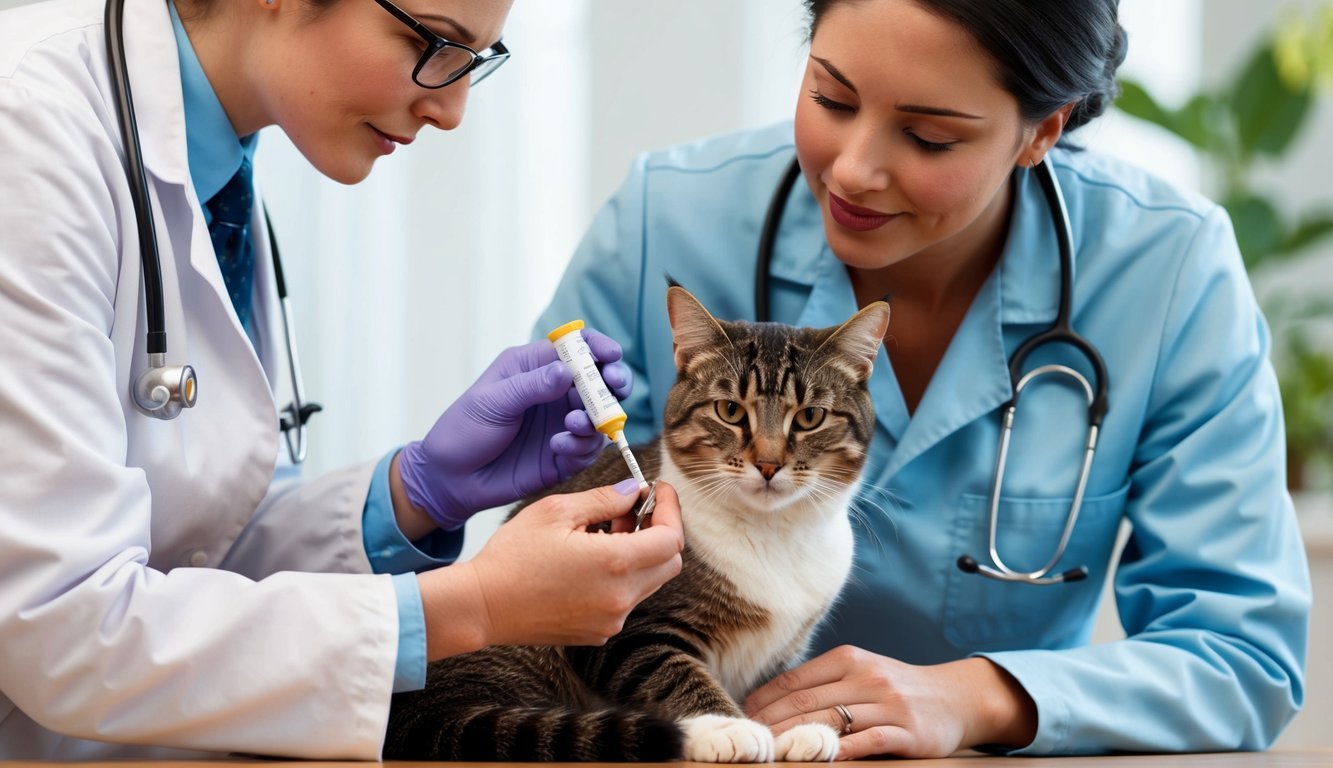
Managing your cat’s diabetes, especially regarding insulin administration, requires consistent support and effective caregiving strategies.
Here are important aspects to consider in your journey.
Tips for Caregivers
Establish a routine for giving insulin injections.
Cats respond better when their schedule remains consistent.
Aim for the same time each day, ideally every 12 hours.
Monitor your cat’s blood sugar levels regularly.
Use a glucometer designed for pets, as it can provide accurate readings.
Keeping a log of glucose levels will help you and your veterinarian adjust insulin doses as needed.
Learn to recognize signs of hypoglycemia, such as weakness or confusion.
If you notice these symptoms, you can quickly administer a small amount of honey or a high-sugar treat to rectify the issue.
Additionally, providing a balanced diet plays a crucial role.
Consult with your veterinarian about special diets designed for diabetic cats that will help regulate their blood sugar.
Veterinary Assistance and Support Groups
Don’t hesitate to reach out for veterinary assistance if you have questions or concerns.
Regular check-ups are vital, allowing the vet to monitor insulin effectiveness and make necessary adjustments.
Consider joining support groups for pet owners managing feline diabetes.
These communities can provide emotional support and practical advice.
You can share experiences, learn new techniques for insulin injections, and discuss challenges.
Resources like VetPen offer information and tools specifically designed for pet diabetes care.
Utilize their materials to enhance your knowledge.
Connecting with other caregivers can give you confidence and encouragement, making your journey easier and more manageable.
Summary and Key Takeaways
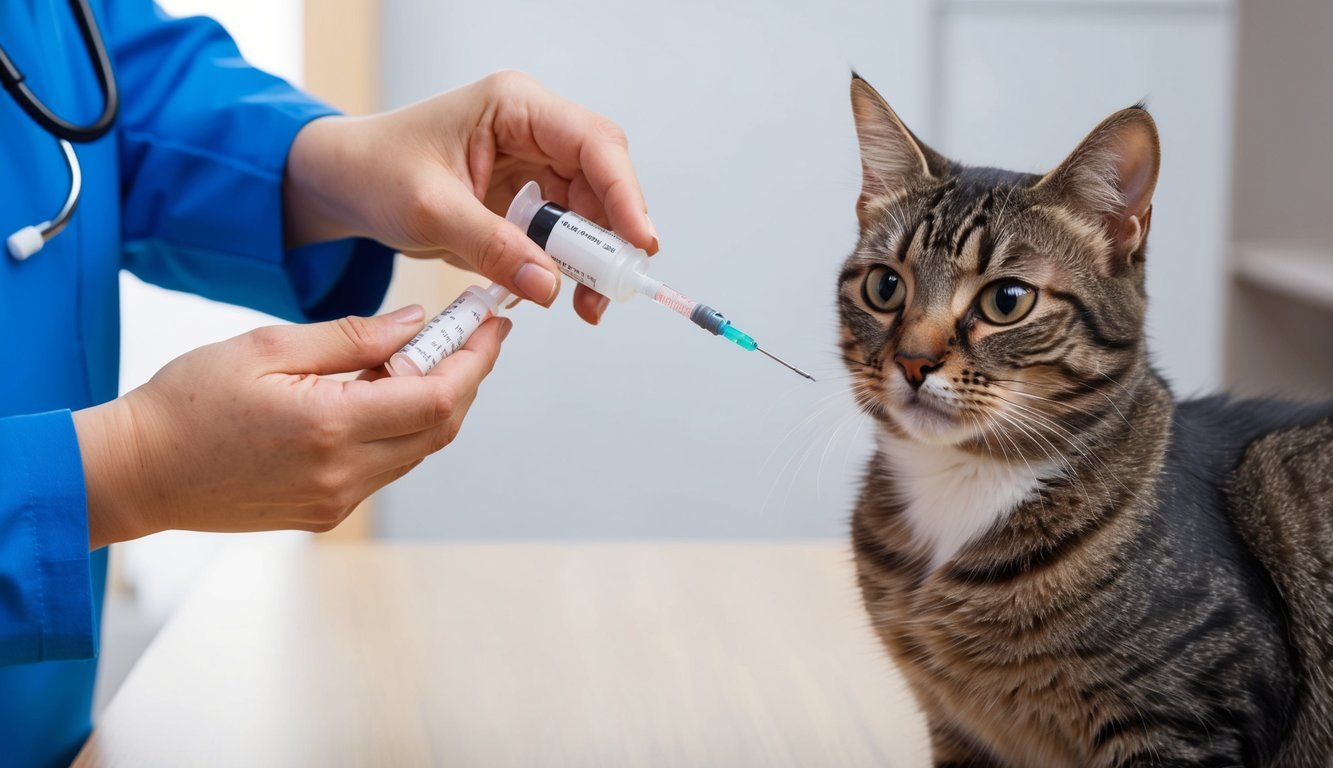
When managing feline diabetes, understanding insulin dosage is crucial.
The maximum starting dose for cats usually does not exceed 2 U per injection, given every 12 hours.
Most diabetic cats stabilize at an average dose of 0.5 U/kg.
Here are some key points to remember:
- Insulin Types: Common options include glargine and PZI (ProZinc). Each type can have different potencies.
- Dosing Range: Effective dosing typically falls between 0.2 U/kg and 0.8 U/kg.
- Monitoring: Regular monitoring of blood glucose concentration is vital to adjust dosages safely.
Your cat’s insulin sensitivity may vary, meaning some may require higher or lower doses.
If your cat has conditions like pancreatitis, this may also impact insulin needs.
Here’s a quick reference table:
| Insulin Type | Starting Dose | Usual Regulation Dose |
|---|---|---|
| Glargine | 0.25 IU/kg BID | 0.5 U/kg |
| PZI | 1-2 U per cat | 0.2 – 0.8 U/kg |
Always consult your veterinarian for personalized guidelines and adjustments as your cat responds to treatment.
Understanding these dosing parameters will help you manage your diabetic cat’s health effectively.
Frequently Asked Questions
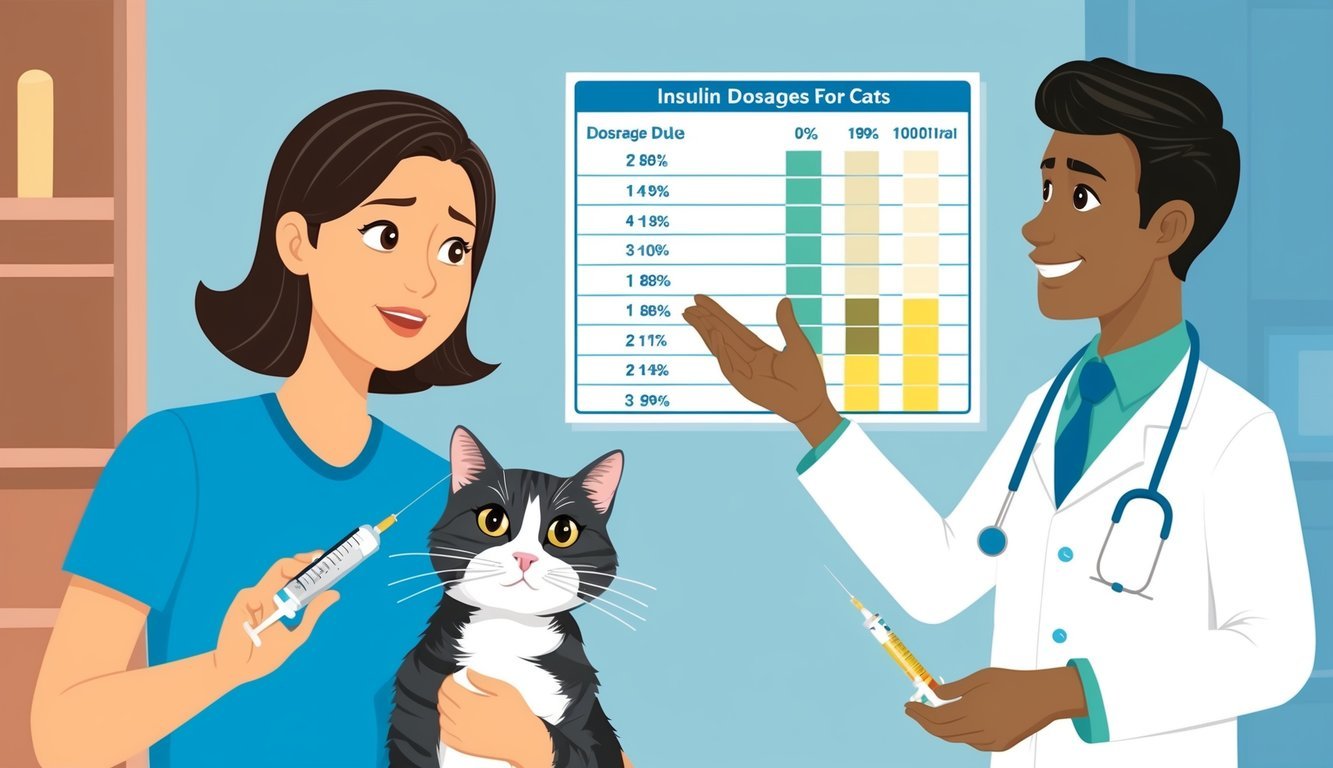
When managing diabetes in your cat, determining the right insulin dosage is crucial.
There are specific guidelines and signs to watch for that can help you in administering the correct amount of insulin.
How much insulin should I typically give my cat?
The typical starting dose for insulin in cats ranges from 0.2 to 0.5 IU/kg every 12 hours.
Many cats stabilize well with doses averaging around 2 U but can vary based on individual needs.
What signs indicate that my cat needs an increase in their insulin dosage?
If your cat shows symptoms such as excessive thirst, frequent urination, or increased appetite despite receiving insulin, it may be time to reassess the dosage.
Regular monitoring of blood sugar levels can provide additional insight into whether adjustments are necessary.
Is there a standard dosage chart for administering Lantus insulin to cats?
While there isn’t a universally accepted dosage chart for Lantus in cats, many veterinarians recommend starting with a dose of around 1 U per cat and adjusting based on individual responses.
Regular vet check-ups are essential for tailoring the dosage.
What’s considered a high dose of insulin for a cat?
A high dose of insulin for a cat typically exceeds 2 U per injection at each administration.
Most cats do well on doses less than 1 U/kg, so anything significantly above may warrant discussion with your veterinarian.
How do I calculate the correct insulin dosage for my cat based on their weight?
To calculate the dosage, multiply your cat’s weight in kilograms by the recommended IU/kg dose.
For example, if your cat weighs 5 kg and your vet suggests 0.5 IU/kg, the dosage would be 2.5 IU.
At what point is the amount of insulin given to a diabetic cat deemed too much?
If you notice negative side effects like lethargy, weakness, or confusion, it may indicate that the insulin dosage is too high.
Regular blood glucose monitoring is critical to help identify when adjustments are needed to prevent potential hypoglycemia.

